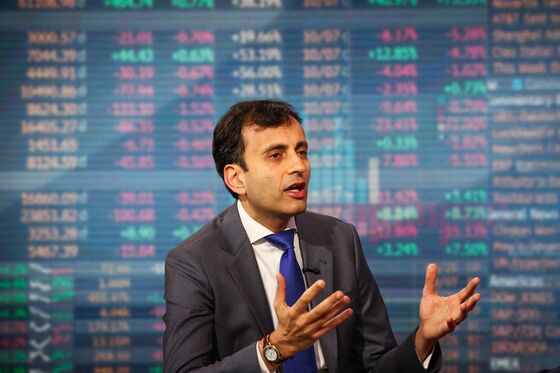Global Growth Boom May Disappoint, Morgan Stanley’s Sharma Warns
Fault lines include U.S. consumers, China’s tech crackdown. Zombie companies will inevitably drag on creative destruction.
(Bloomberg) -- China’s regulatory crackdown on its technology sector and U.S. consumers possibly saving more than they spend are twin risks facing the world’s economic recovery, according to Ruchir Sharma, head of emerging markets and chief global strategist at Morgan Stanley Investment Management.
Sharma, who is the author of bestsellers including “Breakout Nations” in 2012 and “The Rise and Fall of Nations” in 2016, isn’t predicting a global bust. What he’s warning is that the consensus for a robust boom may be overlooking downside risks that may cause momentum to fade sooner than expected.
Here are excerpts of the conversation with Sharma, whose most recent book is “The 10 Rules of Successful Nations.”

How are you viewing the global economic recovery right now? Where is it headed?
I am a bit concerned that you have a very strong consensus out there that we are all set for a major economic boom to take place -- the growth estimates are still flying high. So what can go wrong is a question that bothers me and the bond market seems to be asking the same question. There are two fault lines developing in this global economic boom that we need to be wary about.
Can you elaborate on what those fault lines are?
One has to do with China. The whole crackdown on the tech sector is big and regulatory policy plays a tightening effect, as we have seen historically. The digital economy now is by some estimates 40% of China’s economy. This number was 10% a decade ago. The emergence of the new digital economy has been the cash cow and golden goose. I am a bit concerned now that if you are going to crack down, what is going to be the impact on economic growth and how far will that go. That, to me, is a big concern for global economic forecasts.
What’s your other worry?
People in the U.S. think the fiscal spending will fade and everyone thinks that is fine because the consumer is in such good shape and will pick up the slack. The problem is, if you look at the last time consumers had such a windfall, which was after the Second World War, they ended up saving a lot of that money rather than spending. What if the consumer ends up saving a lot of their windfall as they did the last time such a windfall happened? At the same time, there are a lot of consumers still scarred from the 2008 crisis.
Do you have a time frame for when the recovery may slow? How pronounced will that be?
I still feel the recovery has some legs to go, because, as the vaccine rollout speeds up in emerging markets they will do better. So I think the global recovery may not have peaked as yet. But I am concerned that the two big growth engines might be less robust than we think and that means the recovery could peak a lot more quickly than what the consensus expects today. I am not predicting we are going to get a global bust, but the consensus today is very strong that we are going to get a global economic boom. I am looking for where the flaws are in the conventional wisdom.
What would a Federal Reserve tapering mean for emerging markets?
I believe in that old line that history doesn’t repeat itself so quickly. A lot of people have the 2013 fear (taper tantrum) at the back of their mind but I think the fundamentals are different. Yes, there are some emerging markets which are vulnerable, but those are the smaller frontier markets. I would say if you look at the big emerging markets, the vulnerability is less this time -- namely current account deficits and external debt situations. It’s a lot calmer now. I feel much more constructive today than I did a decade ago for emerging markets.
Can you explain more why you’re less worried about emerging markets?
To me, the upturn in the commodity cycle and the fact that the cost of adopting new technologies has fallen a lot and are being adopted very rapidly now across emerging markets, including some of the poorest countries. I think that gives me a lot of optimism about what can drive emerging market growth in the years ahead.
What’s the downside of the massive stimulus since the pandemic crisis began?
We are now in an era of secular stimulus. We keep on giving stimulus and stimulus regardless of the circumstances. I think that has a lot of corrosive, insidious effects -- not in the form of a crisis but in the form of lower and lower productivity over time with the rise of the zombie companies which in turn crowds out the rise of new startups because you have so much deadwood floating. They undermine creative destruction. I think that is the real problem with these high debt levels.
What’s your outlook for India’s economy over coming years?
I’ve used this line about India for so many years and I see no reason to change it: this is a country that consistently disappoints the optimists and the pessimists. India just carries along, it’s very hard to get too optimistic or pessimistic. India only carries out some level of economic reform when they have their back to the wall, so now we have had that back to the wall. It’s a bit early but India is talking about privatization for the first time, it is talking about carrying out some reforms of its labor markets. So at least that is the one silver lining across emerging markets including India -- that the pandemic forces them to reform.
©2021 Bloomberg L.P.

